
The Great Migration is the migration of over a million wildebeest and a few thousand zebras from Tanzania's Serengeti to Kenya's Masai Mara, crossing the Nile's crocodile-infested Mara River. Following the Serengeti/Masai Mara ecosystems' significant rainfall patterns, the animals use their senses to drive them towards richer pastures every year.
Kenya vs Tanzania
With the Great Migration crossing through both Kenya and Tanzania, it can be hard to decide which one is right for your holiday. Some of this will depend on the time of year you wish to travel (see our month-by-month calendar below), but a Kenya safari does have some offer key advantages.
- Ease of access – the Masai Mara is very quick to get to with a direct flight from Nairobi to the Mara, whereas driving safaris tend to be more common in Tanzania which means it takes longer to get to the Serengeti. This is especially worth considering if you are short on time or are travelling as a family with kids.
- The concentration of animals – the wildebeest route in the Mara is more concentrated which can increase your chances of seeing the migration and a river crossing
- Affordability - a Kenyan safari tends to be slightly cheaper than a Tanzanian safari when comparing like-for-like accommodation.
This incredible experience is known as one of Africa’s seven wonders of the natural world - a bucket-list-worthy experience whether you are planning a Kenyan honeymoon, your first safari or a family trip, it is a must.
Migration by month
The Great Migration of wildebeest crosses both the Serengeti in Tanzania and the Masai Mara in Kenya – the time of year you want to travel, plus a few other factors will depend on if you are better to see the migration in Kenya or in Tanzania.
Jan – March is the birthing season when half a million new calves arrive, and this happens in the southern Serengeti, making a Tanzania safari your top choice for this time of year.
April and May bring the wet season, and with it plenty of rain, making this a less popular time to travel to see the wildebeest cross the Serengeti.
June and July see the wildebeest moving northward in the Serengeti and starting to head towards the Masai Mara in Kenya. During these months, the large herds will cross the Grumeti River, which whilst less dramatic than the Mara River crossing is still a fantastic event to witness.
August – September is when the famous Mara River crossings happen as the herds hunt for fresh, greener pastures in the northern Serengeti and in the Masai Mara in Kenya. Once they have cross the Mara river, they will remain here for August to October, before crossing back to follow the rains southward in October.
October –December. The rains begin to fade in October, and the herds begin to migrate south in preparation for the Serengeti's approaching rains. This is the end of the Great Migration in the Masai Mara, until the following year, but the herds will head southward towards the southern Serengeti, ready for calving season in January.
Mara River Crossings
The Mara River crossings are known as the ‘biggest event’ of the entire migration of the wildebeest. Travellers will never forget this life-or-death experience of baby wildebeest and their mothers fighting for their lives, as they attempt to cross the famous Mara River and confront the starving crocodiles. Watching the herds blindly jump into the river is spectacular, to say the least, as they face over 3,000 crocodiles that lurk in the murky waters of the Mara River.
The wildebeest that successfully cross the Mara River are rewarded with the green grass; however, they still face threats of the big cats prowling on the plains of the Masai Mara.
The Mara River, sometimes known as the 'river of death,' is 395 kilometres long and has a surface area of 13,504 km squared. The river starts in the Kenyan highlands of Narok county and flows through the Masai Mara national reserve's grasslands to the northern Serengeti in Tanzania before draining into Lake Victoria, the Nile's main reservoir.
There are various crossing points along the Mara River, with different large herds crossing at different points.
There are two main crossing areas in the Masai Mara
- “Lookout Hill” which is located in the south of the reserve
- “Main Crossing” which are the areas below Serena Camp
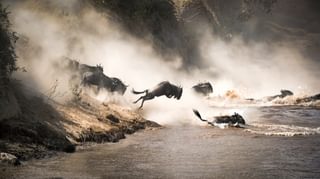
When to see a river crossing
Although the migration usually occurs from July to October, it is difficult to determine exactly when the wildebeest will cross the Mara River until the vast herds have congregated near the Masai Mara national reserve on the Serengeti's northern side. Even once the herds have congregated, they can stand on the edge of the Mara River for several days until one brave wildebeest, quite literally, takes the plunge.
The crossing usually starts mid-July to late August, keeping in mind this is a gradual event that takes place over several weeks at different locations along the Serengeti/Masai Mara border.
The return journey back to the Serengeti happens in late October, however, this is less of a spectacular event as it is more of a slow dispersal.
Best places to stay
If you are specifically looking to see a Mara River crossing, we would recommend staying in the main Masai Mara Reserve, although it is worth noting that this can get busy during peak time. Staying in a conservancy is a quieter option and although a little further from the ‘main’ action, there are no fences so the animals move freely, and you can still take a trip into the main national reserve if you want to. Many of the camps in conservancies are on rivers so you can see a river crossing, it may just not be as dramatic as those crossing the Mara River.
Camps in the Masai Mara National Reserve
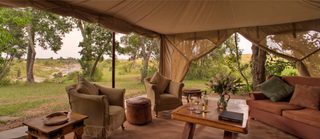
Rekero Tented Camp
Rekero Tented Camp is a seasonal eco-camp, perfectly located to see the Great Migration directly from the camp.
The camp is strategically placed to overlook the Talek River in the Masai Mara National Reserve at one of the main crossing points for the grand annual journey. Guests can enjoy watching the migration and other wildlife from the comfort of their tent, as well as on the decks.
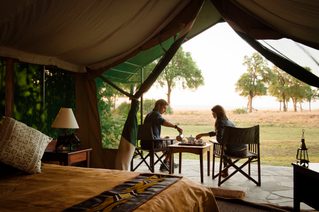
Governors Camp
One of Kenya’s original safari camps, set on the banks of the Mara River and renowned for its excellent guiding, Governor’s Camp is the perfect spot to see the Great Migration. It is a wonderful lodge for a Kenya family holiday too!
The camp has 37 tents lining the riverbank of the famous Mara river tucked amongst the forest with views either over the river or across the sweeping plains of the Masai Mara.
If you are looking for a quieter, smaller camp, Little Governors Camp nearby is an intimate camp which is approached by a boat ride across the Mara River, followed by an escorted walk through the forest – perfect for those looking to get a little more off the beaten track.
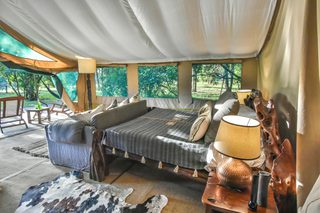
II Moran Camp
II Moran Camp is Governors’ prestige camp. Small and intimate with just 10 luxurious tents and located right on the banks of the River Mara in the heart of the Masai Mara, it offers some of the best game viewing available and is regarded as one of the top camps in the Masai Mara.
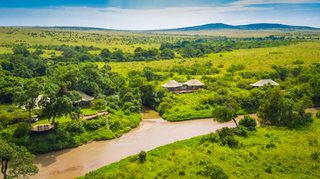
Sala’s Camp
Sala's Camp is nestled along the tree-lined banks of the Sand River in the south of the Masai Mara National Reserve. Its proximity to the Tanzanian border means the camp is one of the first to experience the Great Migration, and it has one of the best viewing spots in Kenya.
Sala's Camp is part of The Safari Collection which includes Giraffe Manor in Nairobi – a hugely popular bucket list hotel where you can feed the giraffes at breakfast, and easy to combine with a Masai Mara trip.
Camps in conservancies
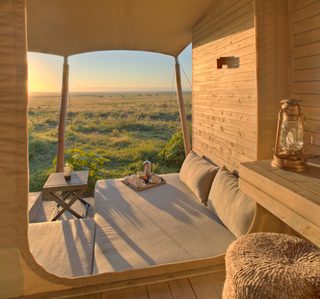
Kichwa Tembo Camp
Kichwa Tembo is set in a private concession in the Masai Mara's western region, beside the Saparingo River and overlooking the beautiful plains of the Masai Mara. The greatest time to witness the big migration at Kichwa Tembo is from the end of August to the beginning of October when the wildebeest begin to migrate northwards
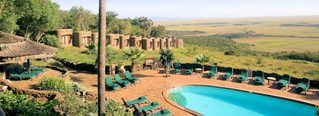
Serena MaraLodge
The Mara Serena Safari Lodge is located in the Mara Triangle Conservancy, right on top of a hill, overlooking the Mara River. This idyllic lodge is a perfect destination to overlook the Mara river right from your bedroom window, and a short journey to witness the migration below the lodge. It also has a gorgeous pool to relax by between safaris.
View from above
If you want to add a once-in-a-lifetime experience to what is already a bucket list event, taking a sunrise hot air balloon over the Masai Mara wildebeest migration followed by a bush breakfast complete with bubbles is something you will never forget.
Floating above the plains you can appreciate the true scale of the migration as you gaze down at the million wildebeest below whilst enjoying the panoramic views from the horizon. As the sun peaks above the horizon, you can see wildebeest, zebra, elephant and gazelle going about their daily business – you could even be lucky enough to see a hunt from above!
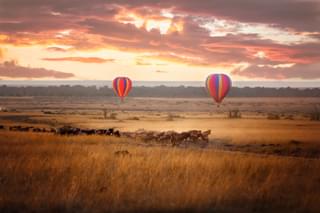
Factors affecting the migration
According to fossil evidence, wildebeests have been roaming our world for over one million years, making the longest and most gruelling trek of their life every year. Climate change, pastures, and the mating and calving seasons all influence the migration, however, it has been discovered that the primary cause for their migration is to follow the rainfall.
Although the migration is normally from south to north, the timing and location of the rain changes every year. As a result, wildebeest migrations can be unexpected, and the Great Migration does not always follow a circular course. It has been determined that it is a south-north path with occasional detours, implying that the herds normally zig-zag up north, then cross the river for a few months before zig-zagging back down.
This, therefore, makes it impossible to predict where the wildebeest will be at any given time.
How the migration supports the ecosystem in the Masai Mara
The wildebeest migration is critical to the Serengeti/Masai Mara ecosystem's survival. When animals migrate, their grazing and trampling of grass encourages the growth of new grass, as well as pollination, and their waste aids in the fertilisation of the soil. They also provide food for a variety of species, including lions, leopards, cheetahs, wild dogs, hyenas, and also various birds such as vultures. They may have a direct impact on predator populations, other wildlife populations, and grass food availability, according to the evidence.
What to combine a Kenya wildebeest migration safari with?
If you have time, we would highly recommend combing the Masai Mara with another area of Kenya so that you can appreciate the huge variety of landscapes and wildlife the country offers, and of course, a few days on the beach to relax and chill at the end of your trip is something many of our clients choose.
Safari options
Lewa- Trailblazers when it comes to wildlife conservation, and thanks to unwavering anti-poaching efforts, here you'll find the largest rhino sanctuary in the country. You’ll also find the big five here, as well as rare Grevy zebras. As well as 4x4 game drives, you can try bush walks, go camel trekking or horse riding across the plains with Mount Kenya making a breathtaking backdrop.
Samburu - named after the colourful tribesmen of this area, Samburu is one of the driest and most dramatic regions in Kenya with incredible panoramic views. Spot the 'Samburu Five', a collection of unusual species found here, as well as lions, elephants and rhinos (you can also track rhino on foot).
Looking for some more inspiration? Take a look at our best safari holidays ideas, our favourite family safaris, our big five safari guide or our top African safari honeymoon suggestions.
Did you know that Kenya is also home to the Big Five? Take at look at our top 5 places to spot the Big 5 in Kenya.































